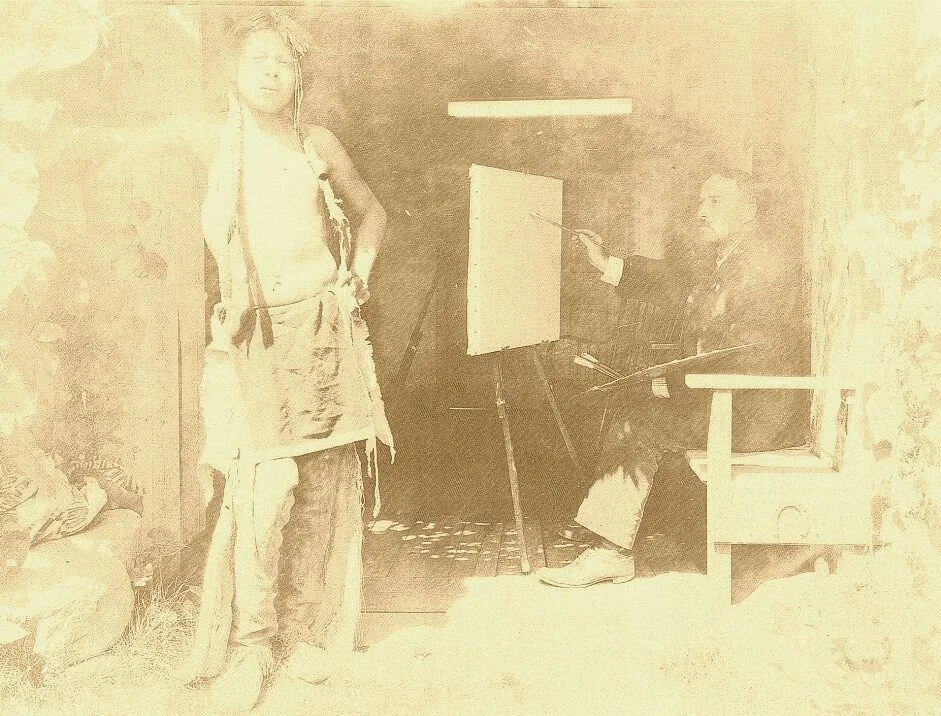Time Travel In A Trunk
By George Bresnick
Buying a piece of furniture rarely reads like a detective story, but when I purchased an immigrant trunk in Minneapolis in 1999, I knew that the opening line of a Holmesian saga had been written. Little did I realize that it would take more than 20 years for the tale to unfold. An evocative feature of some trunks used by 19th-century immigrants is the engraving of their name and destination on the trunk’s lid. It’s not unlike the envelope of an old letter found tucked away in a shoebox filled with memorabilia. In this case, the émigré was ‘Hädda Bergman’ and her new address was ‘Hawley PO, Clay County, Minnesota, Nord Amerka.’
The trunk itself was a delightful example of Old-World craftsmanship, made from natural pine with dovetailed joints reinforced by hand-forged metal strapping. The hinges looked hand-made and the iron lock, original. The trunk was probably late 19th or early 20th century, but without a ‘return address’, I couldn’t say whether it was Danish, Norwegian or Swedish, or even possibly from Hanseatic (Northern) Germany. Each of these countries saw large waves of emigration to the state of Minnesota during that time.
I had bought the trunk primarily for aesthetic reasons, but I was equally intrigued by the trunk as a metaphor of both past and future life. Besides serving as a shipping container for her most essential possessions, the trunk also likely held Hädda’s hopes for new life in ‘Amerka’. Ultimately, it was ‘Hädda Bergman’ herself that I most wanted to connect with. Who was she? Where did she come from? Why was she leaving? And, most alluringly, what happened to her once she arrived in her new home? The fastest way to investigate this was to access the internet, search for her in Clay County, and look for her name on genealogy websites such as ancestry.com.
This was not the first time that I had used the internet like a sifter on an archaeological dig, looking for rare artifacts in a large pile of dirt. For many years, I have been searching for the original owners of numerous documents and other ephemera in my possession, with the intention of returning them either to the living descendants of these people or to local historical societies. I came by some of these antiquities in my youth, scouring local shops and barns with my older brother during summers we spent in a small cottage near Plymouth,
Mass. Much later, he became an antiquities dealer, and it was from him that I inherited many of the items in the collection. I have returned a small cache of legal papers, discovered in the attic of an old Parsonage in Western Mass., to the Stafford, Virginia Courthouse, from which they had been stolen by a Union soldier during the Civil War. I donated to the Florida Historical Society a travel letter from a Yankee notions-huckster, sent from the St. Johns River in Florida in 1884 to family in Westford, Mass. I gave to the Military History Society of Massachusetts an author’s scrapbook of correspondence and newspaper reviews about a book on Napoleon’s Battle of Waterloo, published by a 19th-century historian who was a charter member and president of that society.
Finding Hädda Bergman proved to be a very long investigation, indeed. She did not appear by that name in any of the U.S. Federal or Minnesota Census Records in Clay County from the late 19th to the early 20th century, nor could I find her in immigration or other civil records. I recognized that her maiden name would have been changed if she had married, but I found no clues in local marriage documents. Finally, this past November, I hit ‘pay dirt’. While surfing the web during the Covid-19 confinement, I discovered the following item on the ‘Find a Grave’ website: “Hedda Mary Bergman Sandman, 1863-1921, buried in Dale Covenant Cemetery, Eglon Township, Clay County, Minnesota.” (The spelling of her first name apparently at some time after her arrival in Minnesota was Anglicized to Hedda from Hädda.) From there it was fairly simple to find evidence of her immigration from Sweden to the U.S. in 1889, her marriage to Nicklas Sandman in 1891, and the subsequent births of their three children. I also found her in a ‘public family tree’, which, remarkably, connected me with her grandson, Stan Sandman, who still resides in Clay County, Minnesota, and who lived, until recently, on the original family farm in Hawley. When I contacted him, he was overwhelmed to learn that his grandmother’s trunk survived more than 130 years after her immigration!
Stan Sandman knew his grandfather, Nicklas, but Hädda had died in her fifties before Stan was born. However, he had tracked down her relatives in Sweden and had taken several trips there to meet them and to see the farmstead in Töcksmark, Värmland where Hädda and her seven older siblings were raised. I had imagined what Hädda might have looked like (probably based on my enjoyment of Liv Ullmann in the movie ‘The Emigrants’), but I never dreamed that I would see an actual photo of her taken only a few years after her immigration. I also learned from Stan Sandman and his children, that she originally came to Minnesota to work in a railroad hotel in the newly established railroad town of Winnipeg Junction, so-named because of the transcontinental Northern Pacific Railroad branch to Winnipeg, Canada. It was apparently, there that she met her future husband, Nicklas, who was a farmer in nearby Hawley, and who had come from the same region of Sweden as Hädda.
I initially told the Sandman family that I wanted to keep the trunk for the time being, because I was sentimentally attached to it, but I promised to give it to them at some future time. Then it became obvious to me that the Sandman family, and specifically Hädda’s grandson, should have the joy of living with their ancestor’s possession. On that note, I invited them to my home in St. Paul, where I returned the trunk to them in December 2020. During the handover, we removed our Covid-19 masks long enough to take the picture attached to this article. My brother would have approved.
George Bresnick is a local history buff and author. In honor of his brother, he created the H. Stanley Bresnick Foundation, in whose name he has donated numerous documents, letters, and historical artifacts over the past quarter-century.









